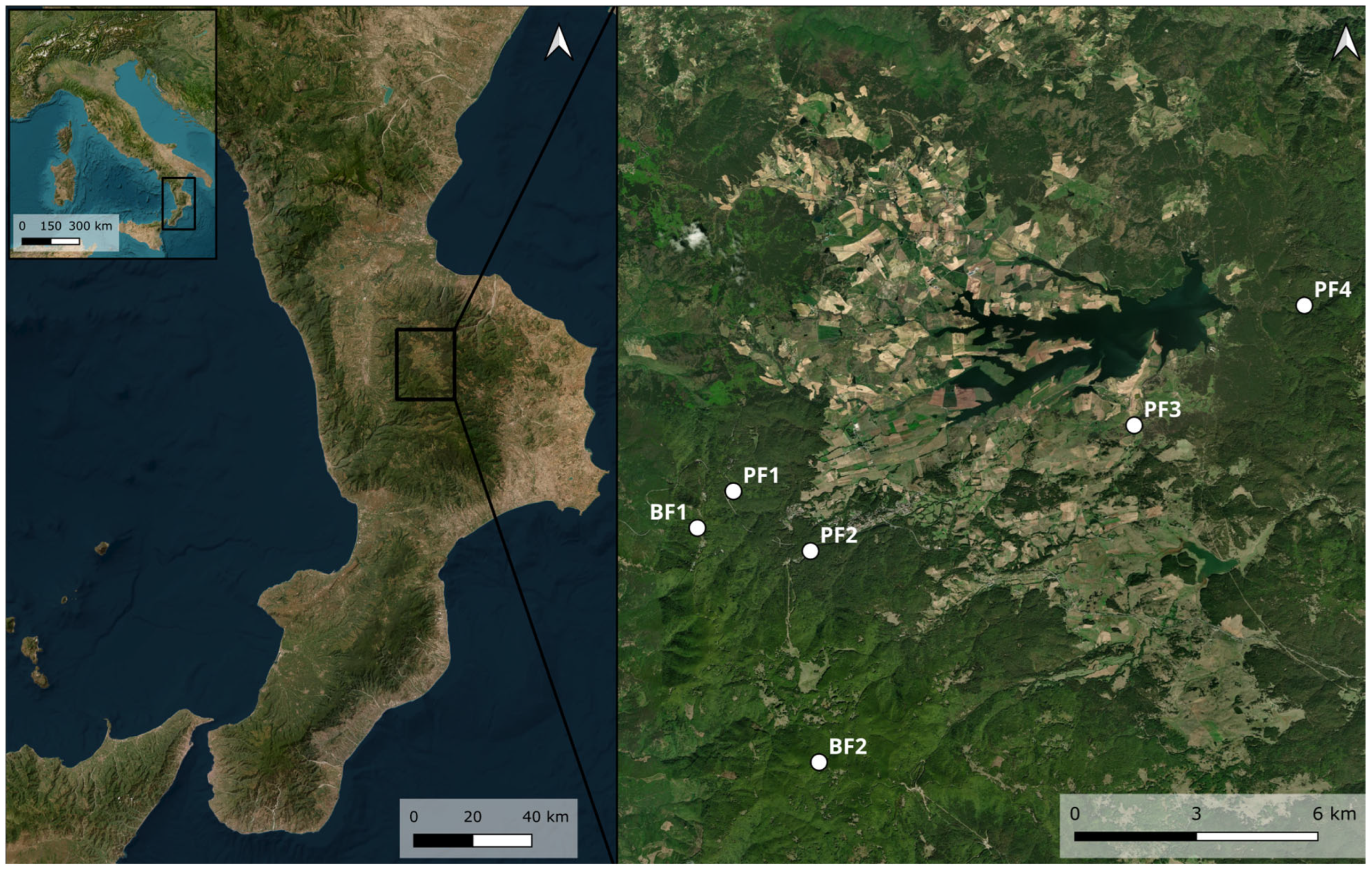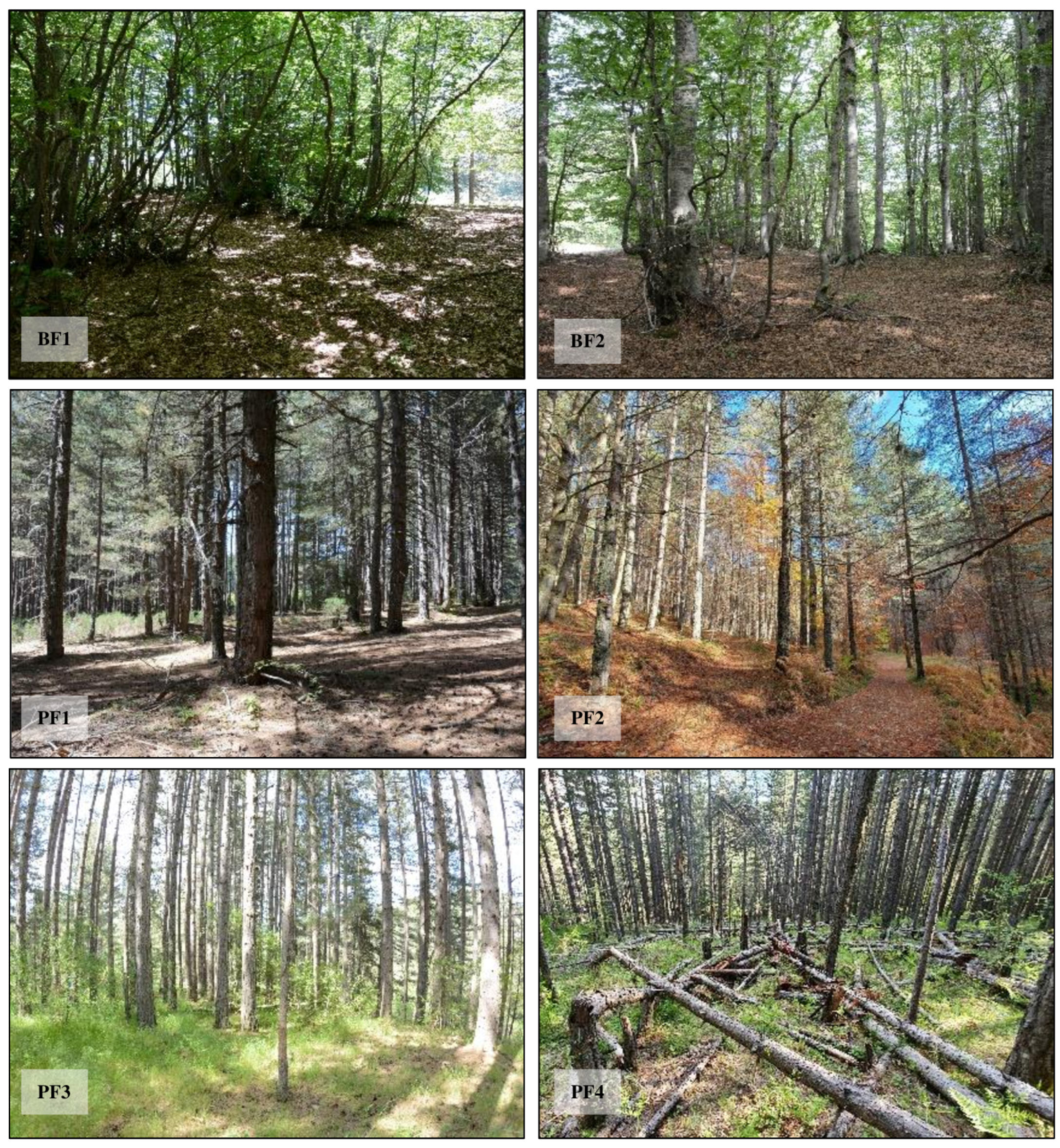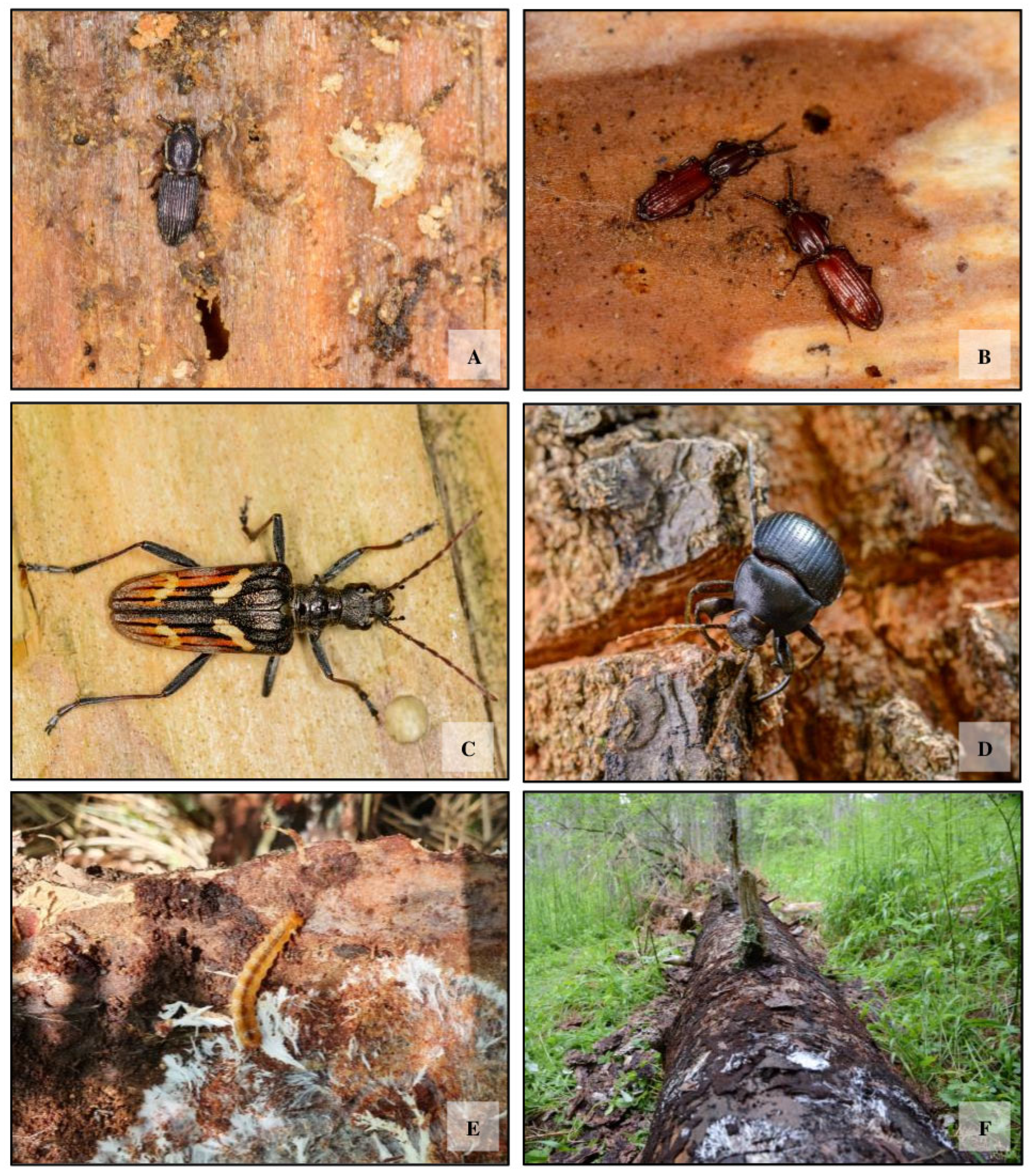Integrated Sampling Approaches Enhance Assessment of Saproxylic Beetle Biodiversity in a Mediterranean Forest Ecosystem (Sila National Park, Italy)
Simple Summary
Abstract
1. Introduction
2. Materials and Methods
2.1. Sampling Area
2.2. Insects’ Collection
2.3. Data Analysis
3. Results
4. Discussion
5. Conclusions
Supplementary Materials
Author Contributions
Funding
Data Availability Statement
Conflicts of Interest
References
- Grove, S.J. Saproxylic insect ecology and the sustainable management of forests. Annu. Rev. Ecol. Evol. Syst. 2002, 33, 1–23. [Google Scholar] [CrossRef]
- Lassauce, A.; Paillet, Y.; Jactel, H.; Bouget, C. Deadwood as a surrogate for forest biodiversity: Meta-analysis of correlations between deadwood volume and species richness of saproxylic organisms. Ecol. Indic. 2011, 11, 1027–1039. [Google Scholar] [CrossRef]
- Tsikas, A.; Karanikola, P. To Conserve or to Control? Endangered Saproxylic Beetles Considered as Forest Pests. Forests 2022, 13, 1929. [Google Scholar] [CrossRef]
- Nieto, A.; Alexander, K.N.A. European Red List of Saproxylic Beetles; Publications Office of the European Union: Luxemburng, 2010. [Google Scholar]
- Calix, M.; Alexander, K.N.A.; Nieto, A.; Dodelin, B.; Soldati, F.; Telnov, D.; Albalate, Z.V.; Aleksandrowicz, O.; Audisio, P.; Istrato, P.; et al. European Red List of Saproxylic Beetles; IUCN: Brussels, Belgium, 2018. [Google Scholar]
- Parisi, F.; Mazziotta, A.; Vangi, E.; Tognetti, R.; Travaglini, D.; Marchetti, M.; D’Amico, G.; Francini, S.; Borghi, C.; Chirici, G. Exposure elevation and forest structure predict the abundance of saproxylic beetles’ communities in mountain managed beech forests. iForest 2023, 16, 155–164. [Google Scholar] [CrossRef]
- Audisio, P.; Baviera, C.; Carpaneto, G.M.; Biscaccianti, A.B.; Battistoni, A.; Teofili, C.; Rondinini, C. Lista Rossa IUCN dei Coleotteri Saproxilici Italiani; Comitato Italiano IUCN e Ministero dell’Ambiente e della Tutela del Territorio e del Mare: Rome, Italy, 2014; p. 132. [Google Scholar]
- Seibold, S.; Bässler, C.; Brandl, R.; Gossner, M.M.; Thorn, S.; Ulyshen, M.; Müller, J. Experimental studies of dead-wood biodiversity. A review identifying global gaps in knowledge. Biol. Conserv. 2015, 191, 139–149. [Google Scholar] [CrossRef]
- Hardersen, S.; Zapponi, L. Wood degradation and the role of saproxylic insects for lignoforms. Appl. Soil Ecol. 2018, 123, 334–338. [Google Scholar] [CrossRef]
- Parisi, F.; Lombardi, F.; Marziliano, P.A.; Russo, D.; De Cristofaro, A.; Marchetti, M.; Tognetti, R. Diversity of saproxylic beetle communities in chestnut agroforestry systems. iForest 2020, 13, 456–465. [Google Scholar] [CrossRef]
- Zumr, V.; Remes, J.; Pulkrab, K. How to Increase Biodiversity of Saproxylic Beetles in Commercial Stands through Integrated Forest Management in Central Europe. Forests 2021, 12, 814. [Google Scholar] [CrossRef]
- Farashiani, M.E.; Varandi, H.B.; Kazerani, F.; Yarmand, H.; Babaee, M.; Thorn, S.; Lange, F.; Rafiei-Jahed, R.; Müller, J.; Amini, S. A preliminary checklist of saproxylic beetles (Coleoptera) in the Hyrcanian forests of Iran, with distributional data. Check List 2022, 18, 1063–1120. [Google Scholar] [CrossRef]
- Winiger, N.; Handel, A.L.; Ganz, S.; Zielewska-Buttner, K.; Segelbacher, G.; Braunisch, V. Saproxylic beetles respond to habitat variables at different spatial scales depending on variable type and species’ mobility: The need for multi-scale forest structure management. Biodivers. Conserv. 2023, 32, 3355–3377. [Google Scholar] [CrossRef]
- Vogel, S.; Bussler, H.; Finnberg, S.; Müller, J.; Stengel, E.; Thorn, S. Diversity and conservation of saproxylic beetles in 42 European tree species: An experimental approach using early successional stages of branches. Insect Conserv. Divers. 2021, 14, 132–143. [Google Scholar] [CrossRef]
- Carpaneto, G.M.; Baviera, C.; Biscaccianti, A.B.; Brandmayr, P.; Mazzei, A.; Mason, F.; Battistoni, A.; Teofili, C.; Rondinini, C.; Fattorini, S.; et al. A Red List of Italian saproxylic beetles: Taxonomic overview, ecological features and conservation issues (Coleoptera). Fragm. Entomol. 2015, 47, 53–126. [Google Scholar] [CrossRef]
- Zumr, V.; Nakladal, O.; Gallo, J.; Remes, J. Deadwood position matters: Diversity and biomass of saproxylic beetles in a temperate beech forest. For. Ecosyst. 2024, 11, 100174. [Google Scholar] [CrossRef]
- Campanaro, A.; Parisi, F. Open datasets wanted for tracking the insect decline: Let’s start from saproxylic beetles. Biodivers. Data J. 2021, 9, e72741. [Google Scholar] [CrossRef]
- Parisi, F.; Vangi, E.; Francini, S.; Chirici, G.; Travaglini, D.; Marchetti, M.; Tognetti, R. Monitoring the Abundance of Saproxylic Red-Listed Species in a Managed Beech Forest by Landsat Temporal Metrics. For. Ecosyst. 2022, 9, 100050. [Google Scholar] [CrossRef]
- Motta, R. Perché dobbiamo aumentare la quantità di necromassa nelle nostre foreste? Quanta necromassa nelle dobbiamo rilasciare? Forest 2020, 17, 92–100. [Google Scholar] [CrossRef]
- Buse, J.; Ranius, T.; Assmann, T. An endangered longhorn beetle associated with old oaksand its possible role as an ecosystem engineer. Conserv. Biol. 2008, 22, 329–337. [Google Scholar] [CrossRef]
- Bujoczek, L.; Bujoczek, M. Factors influencing the diversity of deadwood, a crucial microhabitat for many rare and endangered saproxylic organisms. Ecol. Indic. 2022, 142, 109197. [Google Scholar] [CrossRef]
- Graf, M.; Lettenmaier, L.; Muller, J.; Hagge, J. Saproxylic beetles trace deadwood and differentiate between deadwood niches before their arrival on potential hosts. Insect Conserv. Divers. 2021, 15, 48–60. [Google Scholar] [CrossRef]
- Hagge, J.; Muller, J.; Bassler, C.; Brandl, R.; Schuldt, A.; Thorn, S.; Seibold, S. Change in saproxylic beetle, fungi and bacteria assemblages along horizontal and vertical gradients of sun-exposure in forest. Biol. Conserv. 2024, 291, 110493. [Google Scholar] [CrossRef]
- Amori, G.; Mazzei, A.; Storino, P.; Urso, S.; Luzzi, G.; Aloise, G.; Gangale, C.; Ouzounov, D.; Luiselli, L.; Pizzolotto, R.; et al. Forest management and conservation of faunal diversity in Italy: A review. Plant Biosyst. 2022, 155, 1226–1239. [Google Scholar] [CrossRef]
- Iovino, F.; Nicolaci, A. Disboscamenti in Calabria: Cause storiche, conseguenze e rimedi. L’Italia For. E Mont. 2016, 71, 281–299. [Google Scholar] [CrossRef]
- Brandmayr, P.; Gangale, C.; Mazzei, A.; Mingozzi, A.; Pizzolotto, R.; Urso, S.; Scalercio, S.; Tripepi, S.; Aloise, G.; Ouzunov, D. L’approfondimento: La Biodiversità Animale e Vegetale Della Sila. Sinergie Rapp. Di Ric. 2013, 37, 71–93. [Google Scholar][Green Version]
- Mazzei, A.; Brandmayr, P.; Contarini, E.; Luzzi, G. I Coleotteri Del Parco Nazionale della Sila. Specie Saproxilobionti Di Maggior Interesse Comunitario, Faunistico E Conservazionistico; Grafica Pollino: Castrovillari, Italy, 2016. [Google Scholar]
- Audisio, P.; Mancini, E.; Sabatelli, S. Unraveling cryptic species diversity in an aposematic sap beetle genus (Coleoptera: Nitidulidae: Cryptarchinae) from northern Europe. Insect Syst. Evol. 2016, 47, 131–148. [Google Scholar] [CrossRef]
- Honek, A. The effect of crop density and microclimate on pitfall trap catches of Carabidae, Staphyiinidae (Coleóptera), and Lycosidae (Araneae) in cereal fields. Pedobiologia 1988, 32, 233–242. [Google Scholar] [CrossRef]
- Brandmayr, P.; Zetto, T.; Pizzolotto, R. I Coleotteri Carabidi Per La Valutazione Ambientale E La Conservazione Della Biodiversità. Manuale Operativo; APAT: Rome, Italy, 2005. [Google Scholar]
- Greco, S.; Brandmayr, P.; Bonacci, T. Synanthropy and temporal variability of Calliphoridae living in Cosenza (Calabria, Southern Italy). J. Insect Sci. 2014, 14, 216. [Google Scholar] [CrossRef] [PubMed]
- Montgomery, G.A.; Belitz, M.W.; Guralnick, R.P.; Tingley, M.W. Standards and Best Practices for Monitoring and Benchmarking Insects. Front. Ecol. Evol. 2021, 8, 579193. [Google Scholar] [CrossRef]
- Bouget, C.; Brustel, H.; Brin, A.; Noblecourt, T. Sampling Saproxylic Beetles with Window Flight Traps: Methodological Insights. Rev. Écol Terre Vie 2008, 10, 21–32. [Google Scholar] [CrossRef]
- Martikainen, P.; Kaila, L. Sampling saproxylic beetles: Lessons from a 10-year monitoring study. Biol. Conserv. 2004, 120, 171–181. [Google Scholar] [CrossRef]
- Ranius, T.; Jansson, N. A comparison of three methods to survey saproxylic beetles in hollow oaks. Biodivers. Conserv. 2002, 11, 1759–1771. [Google Scholar] [CrossRef]
- Vrezec, A.; Ambrožič, Š.; Kapla, A. An Overview of Sampling Methods Tests for Monitoring Schemes of Saproxylic Beetles in the Scope of Natura 2000 in Slovenia. Stud. For. Slov. 2012, 137, 73–90. [Google Scholar]
- Alinvi, O.; Ball, J.P.; Danell, K.; Hjältén, J.; Pettersson, R.B. Sampling saproxylic beetle assemblages in dead wood logs: Comparing window and eclector traps to traditional bark sieving and a refinement. J. Insect Conserv. 2007, 11, 99–112. [Google Scholar] [CrossRef]
- Jonsell, M.; Hansson, J. Comparison of methods for sampling saproxylic beetles in fine wood. Entomol. Fenn. 2007, 18, 232–241. [Google Scholar] [CrossRef]
- Bonacci, T.; Mazzei, A.; Horak, J.; Brandmayr, P. Cucujus tulliae sp., an endemic Mediterranean saproxylic beetle from genus Cucujus Fabricius, 1775 (Coleoptera, Cucujidae), and keys for identification of adults and larvae native to Europe. ZooKeys 2012, 212, 63–79. [Google Scholar] [CrossRef] [PubMed]
- Bonacci, T.; Biscaccianti, A.B.; Siclari, A.; Carlomagno, F.; Bonelli, D.; Mendicino, F.; Plewa, R.; Jaworski, T.; Pezzi, M. Presence of the endangered saproxylic species Cucujus haematodes (Coleoptera: Cucujidae) in Aspromonte National Park (Southern Italy). Eur. Zool. J. 2022, 89, 122–129. [Google Scholar] [CrossRef]
- Pezzi, M.; Carlomagno, F.; Mendicino, F.; Bonelli, D.; Pelle, R.; Leis, M.; Chicca, M.; Bonacci, T. Pycnomerus italicus (Coleoptera: Zopheridae), an Endemic Endangered Species: A New Report on Its Presence in Southern Italy. Forests 2022, 13, 1838. [Google Scholar] [CrossRef]
- Mazzei, A.; Bonacci, T.; Contarini, E.; Zetto, T.; Brandmayr, P. Rediscovering the “umbrella species” candidate Cucujus cinnaberinus (Scopoli, 1763) in southern Italy (Coleoptera Cucujidae), and notes on bionomy. Ital. J. Zool. 2011, 78, 264–270. [Google Scholar] [CrossRef]
- Morelli, S.; Paletto, A.; Tosi, V. Il legno morto dei boschi: Indagine sulla densità basale del legno di alcune specie del Trentino. Forest 2007, 4, 395–406. [Google Scholar] [CrossRef]
- Chinga, J.; Murùa, M.; Barahona-Segovia, R.M.; Gelcich, S. Pan traps: An effective tool for monitoring phenological changes in insect floral visitors and their relationship with floral resources in a coastal Mediterranean forest. Ecol. Indic. 2024, 158, 111336. [Google Scholar] [CrossRef]
- Skvarla, M.J.; Larson, J.L.; Fisher, J.R.; Dowling, A.P.G. A Review of Terrestrial and Canopy Malaise Traps. Ann. Entomol. Soc. Am. 2021, 114, 27–47. [Google Scholar] [CrossRef]
- Siewers, J.; Schirmel, J.; Buchholz, S. The efficiency of pitfall traps as a method of sampling epigeal arthropods in litter rich forest habitats. Eur. J. Entomol. 2014, 111, 69–74. [Google Scholar] [CrossRef]
- Hwang, C.; Turner, B.D. Spatial and temporal variability of necrophagous Diptera from urban to rural areas. Med. Vet. Entomol. 2005, 19, 379–391. [Google Scholar] [CrossRef] [PubMed]
- Pezzi, M.; Bonelli, D.; Mendicino, F.; Carlomagno, F.; Munari, C.; Mistri, M.; Chicca, M.; Szpila, K.; Bonacci, T. Calliphora rohdendorfi (Grunin, 1966) (Diptera: Calliphoridae): A new blow fly in the Italian fauna detected in Calabrian Apennines. Eur. Zool. J. 2024, 91, 395–405. [Google Scholar] [CrossRef]
- Porta, A. Fauna Coleopterorum Italica. Vol I—Adephaga; Stabilimento Tipografico Piacentino: Piacenza, Italy, 1923. [Google Scholar]
- Porta, A. Fauna Coleopterorum Italica. Vol II—Staphylinoidea; Stabilimento Tipografico Piacentino: Piacenza, Italy, 1926. [Google Scholar]
- Porta, A. Fauna Coleopterorum Italica. Vol III—Diversicornia; Stabilimento Tipografico Piacentino: Piacenza, Italy, 1929. [Google Scholar]
- Käfer Europas; Die Käfer Europas. Ein Bestimmungswerk im Internet, Herausgegeben von Arved Lompe, Nienburg/Weser, Begründet im September 2002. Available online: http://coleonet.de/coleo/index.htm (accessed on 15 October 2024).
- Candy, S.G. The application of generalized linear mixed models to multi-level sampling for insect population monitoring. Environ. Ecol. Stat. 2000, 7, 217–238. [Google Scholar] [CrossRef]
- Doychev, D.; Georgiev, G. New and rare longhorn beetles (Coleoptera: Cerambycidae) in Bulgaria. Acta Zool. Bulg. 2004, 56, 167–174. [Google Scholar]
- Pelletier, G.; Hébert, C. The Cryptophagidae of Canada and the northern United States of America. Can. J. Arthropod Identif. 2019, 40, 305. [Google Scholar] [CrossRef]
- Redolfi De Zan, L.; Bellotti, F.; D’Amato, D.; Carpaneto, G.M. Saproxylic beetles in three relict beech forests of central Italy: Analysis of environmental parameters and implications for forest management. For. Ecol. Manag. 2014, 328, 229–244. [Google Scholar] [CrossRef]




| Site Code | Altitude (in Meters a.s.l.) | Site Quality | SDT | CWD | FWD | Tree Species |
|---|---|---|---|---|---|---|
| BF1 | 1580 m | MQ | - | - | 30 (4.010 ± 1.30) | F. sylvatica |
| BF2 | 1820 m | HQ | - | - | 71 (4.26 ± 1.15) | F. sylvatica |
| PF1 | 1425 m | MQ | 24 (15.54 ± 2.51) | - | 84 (5.30 ± 2.03) | P. nigra |
| PF2 | 1320 m | MQ | - | - | 18 (3.72 ± 1.18) | P. nigra and F. sylvatica |
| PF3 | 1192 m | MQ | 4 (17.25 ± 5.97) | - | 10 (7 ± 2.45) | P. nigra |
| PF4 | 1275 m | HQ | 46 (27.30 ± 10.88) | 50 (34.58 ± 9.55) | 14 (7.64 ± 2.34) | P. nigra |
| BBT | PaT | MT | PT | VC | |
| Species | 5 | 32 | 16 | 24 | 7 |
| Specimens | 17 | 166 | 30 | 302 | 30 |
| SD | 1.1801 | 7.469 | 1.268 | 13.536 | 1.740 |
| Dominance | 0.272 | 0.136 | 0.0965 | 0.138 | 0.198 |
| Simpson | 0.728 | 0.864 | 0.903 | 0.862 | 0.802 |
| Shannon | 1.452 | 2.674 | 2.715 | 2.386 | 1.743 |
| Evenness | 0.854 | 0.453 | 0.944 | 0.453 | 0.816 |
| Margalef | 1.412 | 6.064 | 4.41 | 4.028 | 1.764 |
Disclaimer/Publisher’s Note: The statements, opinions and data contained in all publications are solely those of the individual author(s) and contributor(s) and not of MDPI and/or the editor(s). MDPI and/or the editor(s) disclaim responsibility for any injury to people or property resulting from any ideas, methods, instructions or products referred to in the content. |
© 2025 by the authors. Licensee MDPI, Basel, Switzerland. This article is an open access article distributed under the terms and conditions of the Creative Commons Attribution (CC BY) license (https://creativecommons.org/licenses/by/4.0/).
Share and Cite
Mendicino, F.; Carlomagno, F.; Bonelli, D.; Di Biase, E.; Fumo, F.; Bonacci, T. Integrated Sampling Approaches Enhance Assessment of Saproxylic Beetle Biodiversity in a Mediterranean Forest Ecosystem (Sila National Park, Italy). Insects 2025, 16, 812. https://doi.org/10.3390/insects16080812
Mendicino F, Carlomagno F, Bonelli D, Di Biase E, Fumo F, Bonacci T. Integrated Sampling Approaches Enhance Assessment of Saproxylic Beetle Biodiversity in a Mediterranean Forest Ecosystem (Sila National Park, Italy). Insects. 2025; 16(8):812. https://doi.org/10.3390/insects16080812
Chicago/Turabian StyleMendicino, Federica, Francesco Carlomagno, Domenico Bonelli, Erica Di Biase, Federica Fumo, and Teresa Bonacci. 2025. "Integrated Sampling Approaches Enhance Assessment of Saproxylic Beetle Biodiversity in a Mediterranean Forest Ecosystem (Sila National Park, Italy)" Insects 16, no. 8: 812. https://doi.org/10.3390/insects16080812
APA StyleMendicino, F., Carlomagno, F., Bonelli, D., Di Biase, E., Fumo, F., & Bonacci, T. (2025). Integrated Sampling Approaches Enhance Assessment of Saproxylic Beetle Biodiversity in a Mediterranean Forest Ecosystem (Sila National Park, Italy). Insects, 16(8), 812. https://doi.org/10.3390/insects16080812











